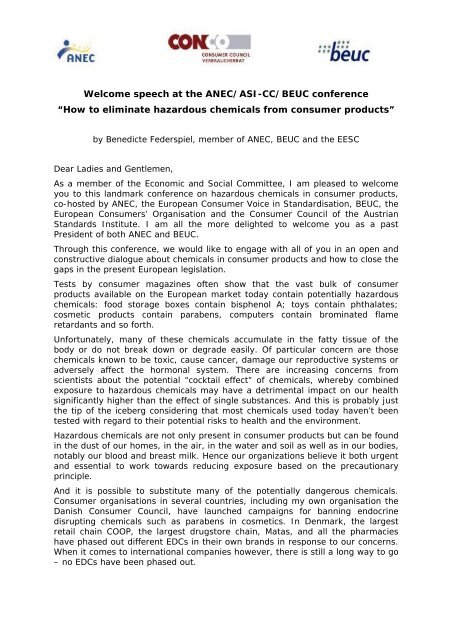Create successful ePaper yourself
Turn your PDF publications into a flip-book with our unique Google optimized e-Paper software.
<strong>Welcome</strong> <strong>speech</strong> at <strong>the</strong> <strong>ANEC</strong>/ASI-CC/BEUC <strong>conference</strong><br />
“How <strong>to</strong> eliminate hazardous chemicals from consumer products”<br />
by Benedicte Federspiel, member of <strong>ANEC</strong>, BEUC and <strong>the</strong> EESC<br />
Dear Ladies and Gentlemen,<br />
As a member of <strong>the</strong> Economic and Social Committee, I am pleased <strong>to</strong> welcome<br />
you <strong>to</strong> this landmark <strong>conference</strong> on hazardous chemicals in consumer products,<br />
co-hosted by <strong>ANEC</strong>, <strong>the</strong> European Consumer Voice in Standardisation, BEUC, <strong>the</strong><br />
European Consumers’ Organisation and <strong>the</strong> Consumer Council of <strong>the</strong> Austrian<br />
Standards Institute. I am all <strong>the</strong> more delighted <strong>to</strong> welcome you as a past<br />
President of both <strong>ANEC</strong> and BEUC.<br />
Through this <strong>conference</strong>, we would like <strong>to</strong> engage with all of you in an open and<br />
constructive dialogue about chemicals in consumer products and how <strong>to</strong> close <strong>the</strong><br />
gaps in <strong>the</strong> present European legislation.<br />
Tests by consumer magazines often show that <strong>the</strong> vast bulk of consumer<br />
products available on <strong>the</strong> European market <strong>to</strong>day contain potentially hazardous<br />
chemicals: food s<strong>to</strong>rage boxes contain bisphenol A; <strong>to</strong>ys contain phthalates;<br />
cosmetic products contain parabens, computers contain brominated flame<br />
retardants and so forth.<br />
Unfortunately, many of <strong>the</strong>se chemicals accumulate in <strong>the</strong> fatty tissue of <strong>the</strong><br />
body or do not break down or degrade easily. Of particular concern are those<br />
chemicals known <strong>to</strong> be <strong>to</strong>xic, cause cancer, damage our reproductive systems or<br />
adversely affect <strong>the</strong> hormonal system. There are increasing concerns from<br />
scientists about <strong>the</strong> potential “cocktail effect” of chemicals, whereby combined<br />
exposure <strong>to</strong> hazardous chemicals may have a detrimental impact on our health<br />
significantly higher than <strong>the</strong> effect of single substances. And this is probably just<br />
<strong>the</strong> tip of <strong>the</strong> iceberg considering that most chemicals used <strong>to</strong>day haven’t been<br />
tested with regard <strong>to</strong> <strong>the</strong>ir potential risks <strong>to</strong> health and <strong>the</strong> environment.<br />
Hazardous chemicals are not only present in consumer products but can be found<br />
in <strong>the</strong> dust of our homes, in <strong>the</strong> air, in <strong>the</strong> water and soil as well as in our bodies,<br />
notably our blood and breast milk. Hence our organizations believe it both urgent<br />
and essential <strong>to</strong> work <strong>to</strong>wards reducing exposure based on <strong>the</strong> precautionary<br />
principle.<br />
And it is possible <strong>to</strong> substitute many of <strong>the</strong> potentially dangerous chemicals.<br />
Consumer organisations in several countries, including my own organisation <strong>the</strong><br />
Danish Consumer Council, have launched campaigns for banning endocrine<br />
disrupting chemicals such as parabens in cosmetics. In Denmark, <strong>the</strong> largest<br />
retail chain COOP, <strong>the</strong> largest drugs<strong>to</strong>re chain, Matas, and all <strong>the</strong> pharmacies<br />
have phased out different EDCs in <strong>the</strong>ir own brands in response <strong>to</strong> our concerns.<br />
When it comes <strong>to</strong> international companies however, <strong>the</strong>re is still a long way <strong>to</strong> go<br />
– no EDCs have been phased out.<br />
1
It seems as if industry is sitting on <strong>the</strong>ir hands waiting for regulation, and if <strong>the</strong>y<br />
do not sit on <strong>the</strong>ir hands <strong>the</strong>y are actively fighting regulation. Industry needs <strong>to</strong><br />
look at <strong>the</strong> lessons learned from <strong>the</strong> past, where early warnings about dangerous<br />
chemicals were ignored. What about <strong>the</strong> current discussion about Bisphenol A in<br />
food containers? BPA has been phased out in baby bottles but what are we<br />
waiting for before banning it in every food contact materials? No later than last<br />
week, <strong>the</strong> French Food Safety Authority itself called for a <strong>to</strong>tal ban of <strong>the</strong> use of<br />
BPA based on two recent alarming studies. As we see it, <strong>the</strong> mounting evidence<br />
of a cocktail effect is an early warning we all have <strong>to</strong> listen <strong>to</strong> and industry and<br />
regula<strong>to</strong>rs must react upon.<br />
The lack of voluntary substitution of dangerous chemicals from industry worries<br />
us. But we also have very serious concerns about how <strong>the</strong> EU assesses and<br />
regulates chemicals contained in consumer products. Legal provisions exist for<br />
many different product groups such as <strong>to</strong>ys, cosmetics and food contact<br />
materials but <strong>the</strong>y are often vague or insufficient <strong>to</strong> ensure a high level of<br />
protection for consumers. There are huge gaps in <strong>the</strong> European legislative<br />
framework and no coherent approach. And industry is not helped in reducing <strong>the</strong><br />
risks <strong>to</strong> health and <strong>the</strong> environment through such a piecemeal approach.<br />
In 2006, <strong>the</strong> REACH legislation was adopted <strong>to</strong> regulate chemicals on <strong>the</strong> EU<br />
market. Unfortunately, we are still a long way from seeing chemicals being<br />
systematically assessed for <strong>the</strong>ir effects on health and <strong>the</strong> environment, and<br />
even fur<strong>the</strong>r from seeing a decrease in <strong>the</strong> use of hazardous chemicals in<br />
consumer products.<br />
This is why <strong>ANEC</strong>, ASI-CC and BEUC have decided <strong>to</strong> join forces and launch a<br />
European-wide debate on chemicals in consumer products.<br />
This <strong>conference</strong> aims <strong>to</strong>:<br />
- show <strong>the</strong> gaps in <strong>the</strong> European legislative framework with regard <strong>to</strong> <strong>the</strong><br />
use of hazardous chemicals in consumer products<br />
- discuss how <strong>to</strong> adapt this legislation <strong>to</strong> protect consumers properly<br />
- discuss <strong>the</strong> role of industry in substituting hazardous chemicals<br />
- consider <strong>the</strong> need for an integrated horizontal approach <strong>to</strong> deal with<br />
chemicals in consumer products<br />
We look forward <strong>to</strong> an interesting debate!<br />
END.<br />
2
















